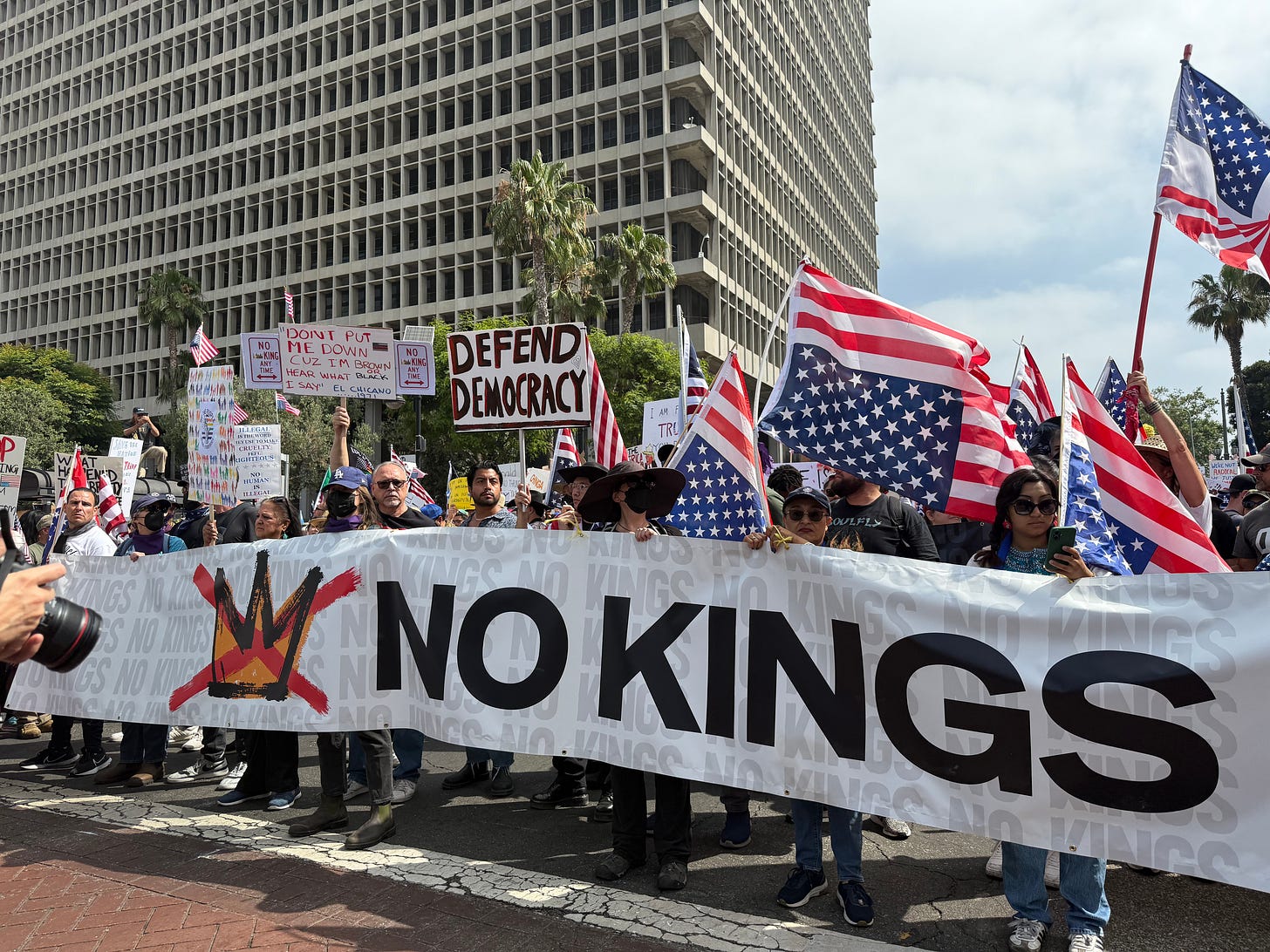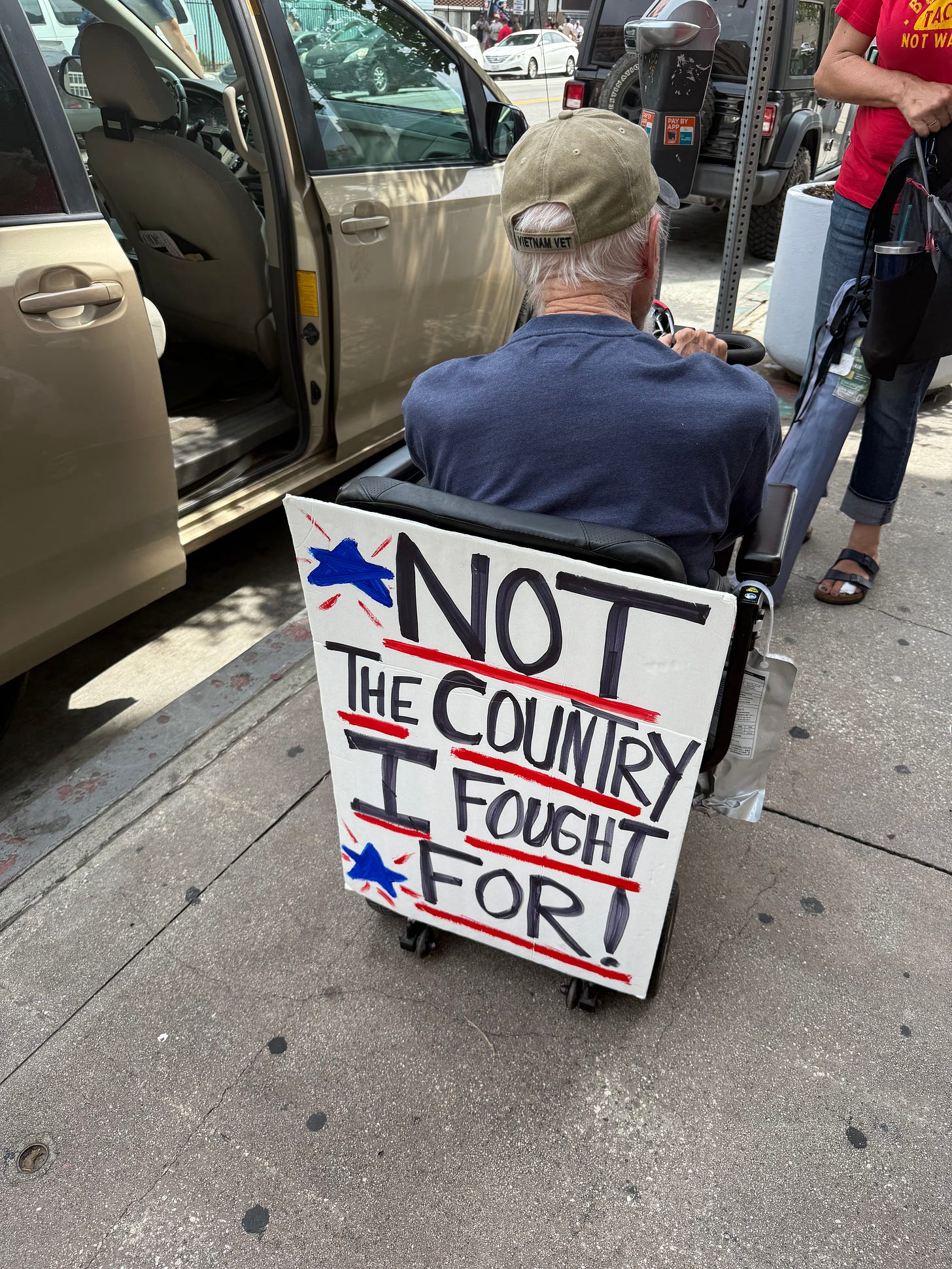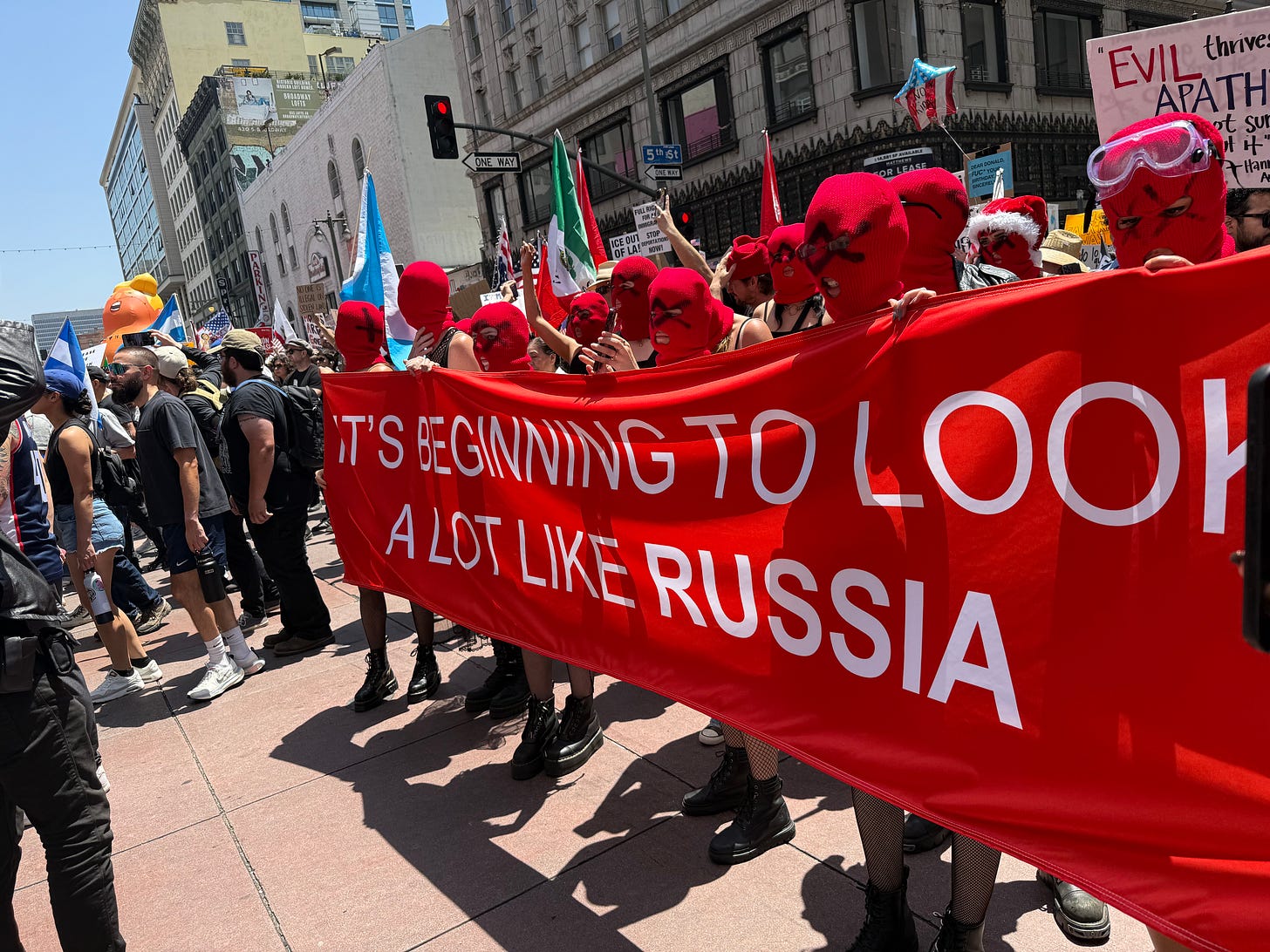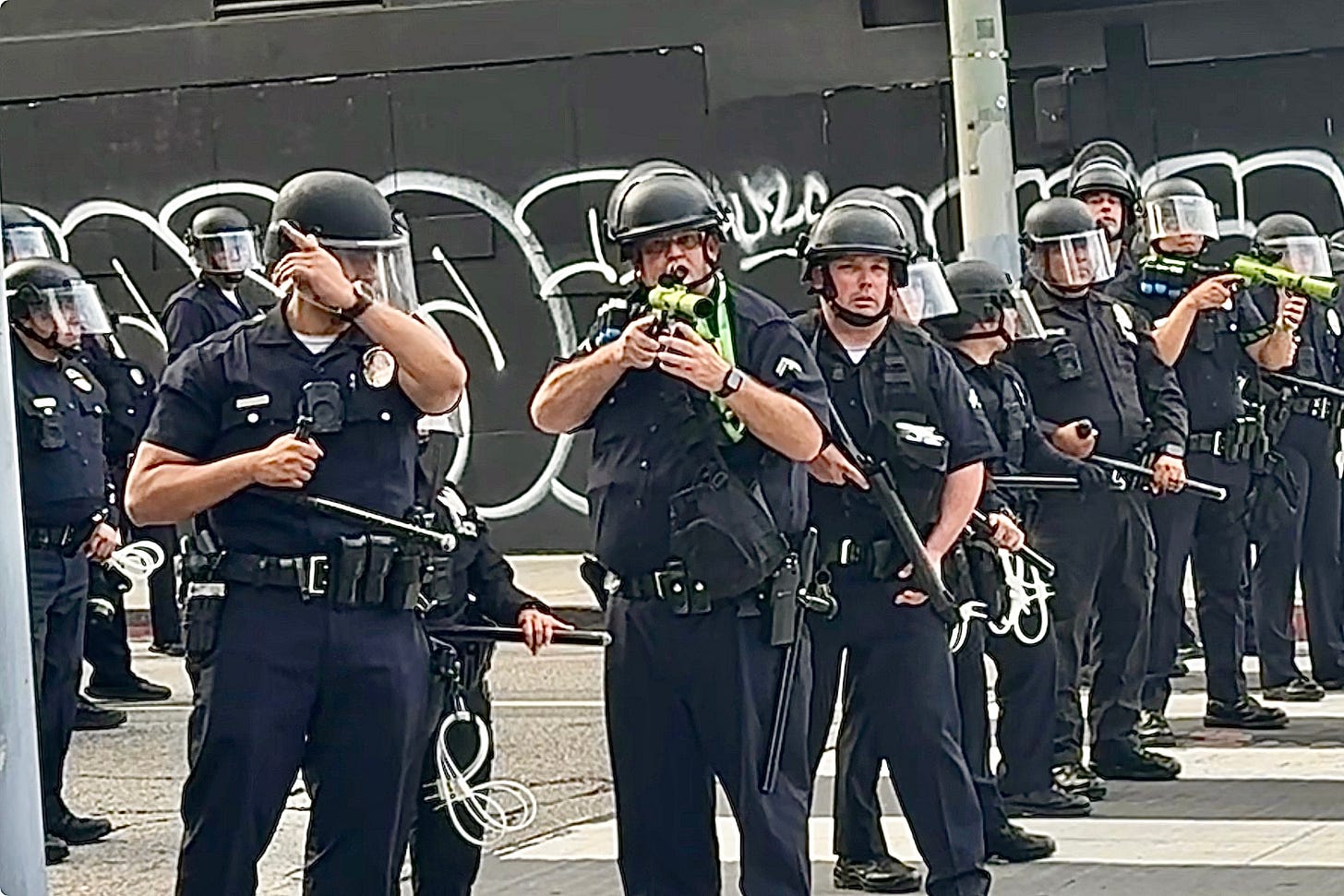US Anti-ICE and 'No Kings' Protests: A Pivotal Moment for Democracy
Zarina Zabrisky reports from Los Angeles on how facts are being manipulated by an authoritarian anti-democratic campaign to crush dissent
The anti-ICE and anti-Trump protests across the US have brought together a wide spectrum of demographic groups demanding an end to immigration raids and authoritarian governance. Harsh ICE raids in Los Angeles targeting schools, hardware stores, and farms, ignited grassroots protests beginning on 6 June. Organizers of the ‘No Kings Day of Defiance’ said 5 million people joined protests in more than 2,100 US cities on Saturday 14 June.
The US Government answered with classic methods of suppression combined with the modern era innovations, in a totalitarian state fashion. The state's response intensified alongside the movement’s growth, employing intimidation to suppress participation.
Weaponizing Fear
Deployments of National Guard troops and Marines in Los Angeles discouraged some from joining. S, a Texas resident, told Byline Times, “I was planning to go, but seeing how horrible it is now in LA, I will not. It is not safe.”
This fear was well-founded. On 9 June, police used force to arrest one participant during a Dallas solidarity rally. Nationally, the US President Donald Trump’s “mask ban”, combined with rumors of facial recognition cameras, heightened anxiety. In an era of digital surveillance, the risk of identification by an authoritarian system is a powerful deterrent.
Similar tactics are used globally: in Tbilisi, Georgia, the pro-Russian ruling party deploys advanced surveillance technology to monitor the ongoing protests there and later arrest their leaders. The same strategy was employed in Ukraine, in occupied Kherson during anti-Russian demonstrations in 2022.
In a troubling development, Customs and Border Protection (CBP) confirmed the use of military-grade Predator drones during the rallies. The deployment of such equipment—designed for war zones—to monitor peaceful demonstrations and assist in ICE operations raises grave civil liberties concerns.
Online disinformation deepened fears. In American Ukrainian-language social media groups, messages urged the diaspora to avoid protests, the linguistic patterns of those messages suggesting Russian origin. Consequently, many Ukrainian-Americans, particularly recent arrivals, stayed away, fracturing the movement’s potential.
Police Violence and Intimidation at ‘No Kings’ Protest in Los Angeles
While most cities reported no major police violence, Los Angeles again stood out. On 14 June, multiple police standoffs were reported during the ‘No Kings’ protests. Additionally, a peacekeeper at a Salt Lake City protest shot at an armed man, injuring him and killing a bystander, authorities said.
In Portland and Virginia, protests turned violent with clashes at an ICE facility and an SUV plowing into a crowd.
Thousands gathered at City Hall in downtown Los Angeles at 9:30 am on a scorching Saturday morning. The protest began with a speech from Native American tribal representatives and words from the organizers: “If you are not Native American, you are an immigrant.”
An inspired dance followed, performed by Native American dancers dressed in feathers and bright costumes, moving to steady drumbeats. A 20-foot balloon of Donald Trump in a diaper was carried through the streets as protesters marched around downtown until 8 pm, chanting “Whose streets? Our streets!”, “No ICE!” and “Russian mole.”
Antonio Villaraigosa, a former Mayor of Los Angeles, told Byline Times, “I think it is beautiful and peaceful [protest] in the tradition of Martin Luther King and Cesar Chavez. We have a right to stand for our democracy… to oppose governmental policies that do not respect civil liberties and human rights.”
The protest impressed with creative energy. Participants wore outfits ranging from the Statue of Liberty to Star Wars characters and held thousands of handmade signs: No ICE, Hands OFF USA, No Kings—alongside slogans like “The Holocaust started with mass deportations” and “Only a sociopath thinks this is okay.” One sign, made from pet food box cardboard, simply read, “Shame!” Protestors carried American and national flags and large banners, “We are the constitution!”
A 98-year-old Vietnam veteran arrived in a wheelchair to “protect our democracy.”
Feminist punk protest group Pussy Riot, wearing red balaclavas, marched with a banner “It’s beginning to look a lot like Russia.” The movement co-founder Nadya Tolokonnikova, in a brief interview with Byline Times, said that she was imprisoned in Russia for two years and opposes the spread of authoritarian rule to the US.
Food markets and cafés along the route stayed open, with protesters pausing at the Central Market to refresh with chilled Mexican sodas, iced lattes, and snacks like pupusas, Thai street food, and ice cream. A wedding procession joined the demonstrators. Street vendors sold sizzling hot dogs and chilli peppers, while volunteers distributed water bottles and sunscreen to help combat the heat.
While the National Guard and Marines stood watch near the federal buildings, no confrontations occurred during the day. Protesters placed flowers by the military lines, greeted the troops, and some painted graffiti urging soldiers to “call their Moms.”
“It is peaceful! I saw babies sleeping in their strollers,” said one protestor.
The police, however, used intimidation unprovoked later in the day. As the demonstrators chanted “Peaceful protest!”, the police charged forward, and aimed guns at both protestors and journalists clearly marked as PRESS, shooting rubber bullets on some occasions.
As a Byline Times journalist, I had a police officer aim a gun at me, and I interviewed a photographer who was injured during the protest.
In the evening, mounted police reportedly wielded batons to assault protesters and blocked rally attendees from entering a train station on their way home.
Despite the protest’s peaceful nature—with people carrying flowers and handmade signs, families pushing strollers, dogs on leashes, and dancers and musicians performing—the gathering was declared “unlawful”. Los Angeles police issued a dispersal order alleging that the protestors threw objects near the downtown federal building. Protesters blamed the escalation on police, who responded with smoke, flash-bangs, and arrested 38.
The use of helicopters to monitor and control rallies was above the average in Los Angeles, where an estimated 200,000 protestors marched downtown.
‘Divide and Conquer’
The diverse and decentralized nature of this budding grassroots movement leaves it vulnerable to both internal divisions and external manipulation—and the combination of both. The very democratic nature of the protestors becomes a challenge. American Jews are often reluctant to march next to college students in Palestinian keffiyeh. Communist imagery such as Soviet flags with hammer and sickle, popular with the left and socialist groups, may trigger military veterans. LGBTQ+ flags do not appeal to Christians who carry crosses at the protests.
National symbols became easy targets. The Mexican flag was used to accuse protesters of separatism. Conservative and pro-Russian accounts spread a misleading video of Mexican President Claudia Sheinbaum, falsely claiming she supported the US protests. Sheinbaum actually called for peace.
The rifts occurring naturally in a democratic society are exploited online by MAGA and Kremlin-aligned propaganda networks to paint the protestors as extremists, anti-American rioters, presenting random examples as generic, in an attempt to form negative public perception.
Provocation and Disinformation: The ‘Reichstag Fire’ Tactic
Subverting and discrediting protests often involves provocation, including attempts to incite violence. Near the Federal Court Building in downtown Los Angeles, police charged at protesters. People chanted, “Peaceful protest!” and raised their arms while police aimed guns at unarmed demonstrators.
When provocations fail, disinformation takes over. A viral post on X falsely blamed “Soros-funded groups,” Mayor Karen Bass, and Governor Gavin Newsom for dropping pallets of bricks near ICE facilities. The photo was actually from a Malaysian construction company, recycling a hoax dating back to the 2020 BLM protests. X users added a community note, and the platform’s AI chatbot Grok issued fact-checks.
Reports of looting and setting cars on fire in downtown Los Angeles were used to represent the movement as violent.
Silencing and Marginalisation
Major TV networks largely skipped downtown Los Angeles. While local channels and independent journalists covered the event, the absence of national press at a gathering of over 200,000 was striking.
The array of suppression tactics—fear, surveillance, disinformation, provocation, and media blackout—suggests that US freedom and democracy are not merely threatened, but risk sliding toward a totalitarian model akin to North Korea, China, and Russia.
Yet, the scale and energy of these protests mark a historic moment. The question remains: will the US succumb to the erosion of its founding principles or emerge stronger, committed to a future with “no kings”?






